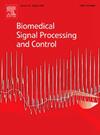基于深度学习的x线片自动地标检测与角度测量在膝关节冠状面对齐分类中的应用
IF 4.9
2区 医学
Q1 ENGINEERING, BIOMEDICAL
引用次数: 0
摘要
基于x线片的膝关节冠状面对齐(CPAK)对于膝关节置换术的术前计划和术后评估都是必不可少的。然而,准确检测膝关节标志的挑战导致膝关节相关角度测量结果不精确,从而导致CPAK分类不可靠。在本文中,我们提出了一种自动化的方法来检测地标,计算膝关节相关角度,并使用双侧下肢x线片进行CPAK分类。具体来说,我们构建了一个数据集并重新训练了一个基于yolo的网络来识别用于地标检测的候选区域。由于图像细节的复杂性,x线照片中的地标检测具有挑战性。为了增强网络利用重要特征的能力,我们引入了双路径融合注意模块,它使用空间变压器网络来关注骨骼区域,并采用高效通道注意模块来增强边缘特征。提出了一种坐标校正模块,促进多尺度特征交互,实现准确的地标定位。通过精确的地标检测,我们的模型实现了可靠的角度测量和CPAK分类。大量的实验证明了该网络的优越性能。髋关节-膝关节角、机械股骨外侧远端角、机械胫骨内侧近端角和关节线收敛角的平均绝对误差分别为0.18°、0.33°、0.75°和0.80°。4个角度的类内相关系数均在0.9以上。本文章由计算机程序翻译,如有差异,请以英文原文为准。
Automatic landmark detection and angle measurement in radiographs based on deep learning in application to coronal plane alignment of the knee classification
The Coronal Plane Alignment of the Knee (CPAK) based on radiographs is essential both for both preoperative planning and postoperative evaluation of knee arthroplasty. However, challenges in accurately detecting knee joint landmarks lead to imprecise knee-related angles measurement results, which in turn result in unreliable CPAK classification. In this paper, we propose an automated method for detecting landmarks, calculating knee-related angles, and performing CPAK classification using bilateral lower limb radiographs. Specifically, we construct a dataset and retrain a YOLO-based network to identify candidate regions for landmark detection. Landmark detection in radiographs is challenging due to the complexity of image details. To enhance the network’s ability to leverage important features, we introduce a Dual-path Fusion Attention Module, which uses Spatial Transformer Networks to focus on the skeletal region, and employs an Efficient Channel Attention Module to enhance edge features. A Coordinate Correction Module is proposed to facilitate multi-scale feature interaction, enabling accurate landmark localization. With precise landmark detection, our model achieves reliable angle measurement and CPAK classification. Extensive experiments demonstrate the superior performance of our network. The mean absolute errors for hip-knee-ankle angle, mechanical lateral distal femoral angle, mechanical medial proximal tibia angle and joint line convergence angle were 0.18°, 0.33°, 0.75° and 0.80° respectively. The intraclass correlation coefficients for all four angles were above 0.9.
求助全文
通过发布文献求助,成功后即可免费获取论文全文。
去求助
来源期刊

Biomedical Signal Processing and Control
工程技术-工程:生物医学
CiteScore
9.80
自引率
13.70%
发文量
822
审稿时长
4 months
期刊介绍:
Biomedical Signal Processing and Control aims to provide a cross-disciplinary international forum for the interchange of information on research in the measurement and analysis of signals and images in clinical medicine and the biological sciences. Emphasis is placed on contributions dealing with the practical, applications-led research on the use of methods and devices in clinical diagnosis, patient monitoring and management.
Biomedical Signal Processing and Control reflects the main areas in which these methods are being used and developed at the interface of both engineering and clinical science. The scope of the journal is defined to include relevant review papers, technical notes, short communications and letters. Tutorial papers and special issues will also be published.
 求助内容:
求助内容: 应助结果提醒方式:
应助结果提醒方式:


